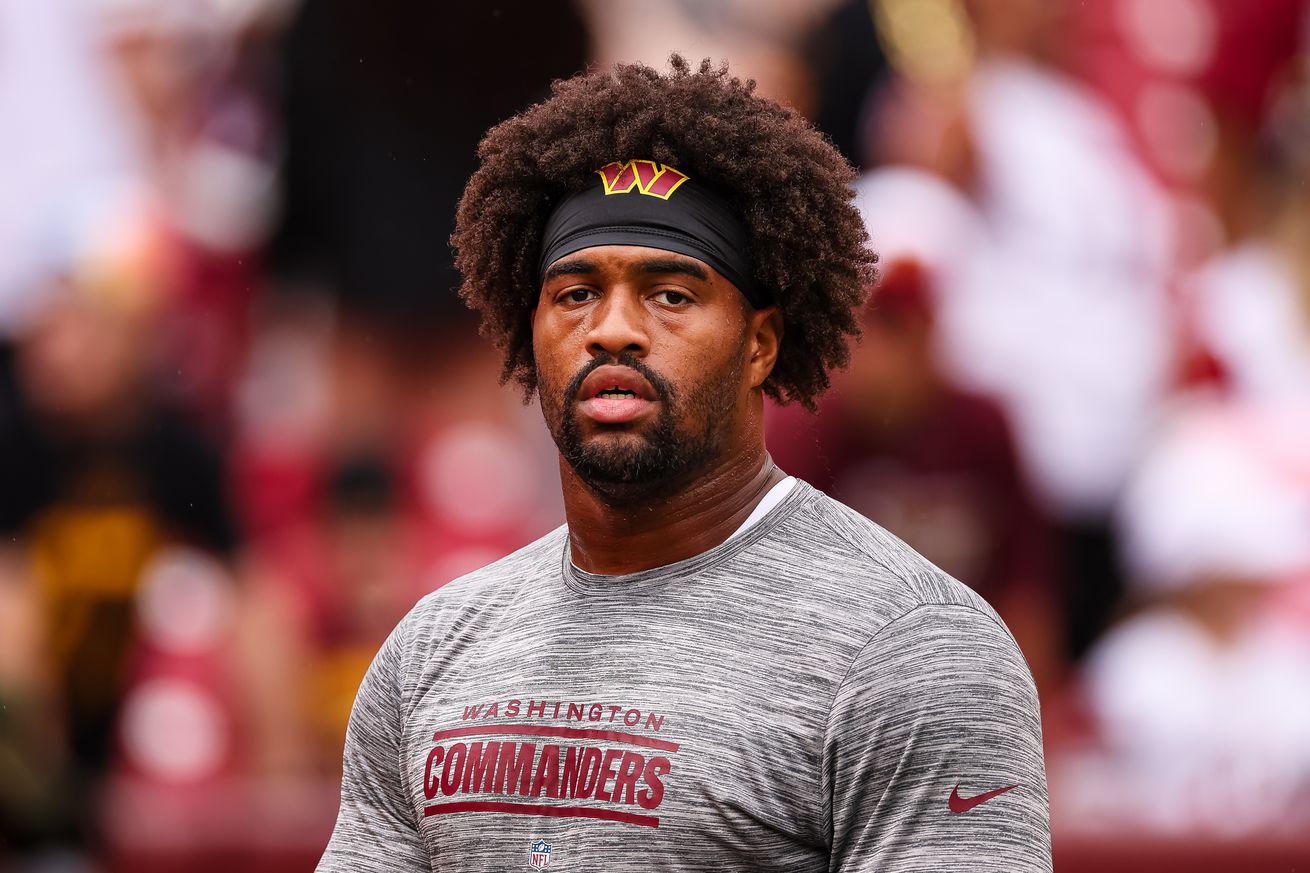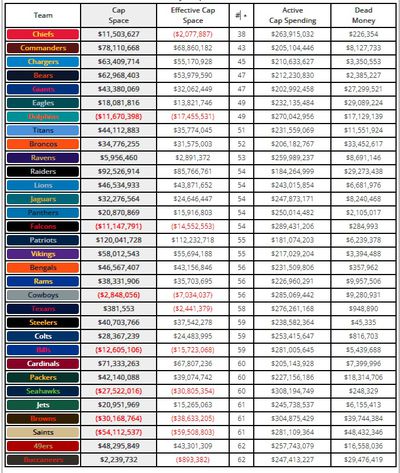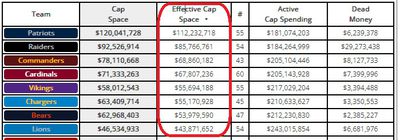
It’s 5 o’clock somewhere…
The 5 o’clock club is published from time to time during the season, and aims to provide a forum for reader-driven discussion at a time of day when there isn’t much NFL news being published. Feel free to introduce topics that interest you in the comments below.
CLICK HERE to see the full 5 o’clock club archive
Wait, what happened to the $100m I kept reading about???
In the middle of the ‘24 season, fans and sports writers frequently referred to the $100m in 2025 cap space that the Commanders were estimated to have available for 2025. The number got repeated so often that it became ‘gospel’, and is still quoted today, though the figure is now badly outdated.
As happens to every NFL team every season, expected available cap space shrinks in December and January as injury replacements are signed and player bonus targets are hit, paying players hundreds of thousands (or even millions) of dollars in bonus money not previously included in cap estimates.
Less than a week ago, Over the Cap estimated Washington’s available cap space to be $87.5m for 2025, but, as always, that number is not written in dried concrete.
Yesterday, the number had dropped to $78.1m as factors like player bonuses and future contracts were factored in. And the estimated available cap space will continue to be updated as new data is incorporated between now and the start of the new league year in mid-March.
Still, $78.1m is the third-highest amount of cap space in the NFL per OTC. Only the Patriots and Raiders are estimated to have more.
Less than a full roster
There’s a major caveat to be aware of when discussing Commanders cap space, however. Washington has the 2nd-fewest players under contract among the NFL’s 32 teams in OTC’s calculations.
The chart below is sorted by roster size for players under contract for 2025. You’ll see that the Chiefs have 38 players; the Commanders have 43 players, and the rest of the teams have at least 45 players under contract for next season.

The two teams ahead of Washington in cap space — New England and Las Vegas — have 55 and 54 players, respectively. The team right behind the Commanders in cap space — the Cardinals at $71.3m — have 60 players under contract.
For an apple-to-apples comparison of available cap space, it is useful to adjust each team’s roster to the top-51 contracts that will count towards the salary cap during the offseason.
Effective Cap Space
Over the Cap actually does this work for us. OTC calculates a separate figure, Effective Cap Space, which OTC says is the cap space a team will have after signing at least 51 players and its projected rookie class to its roster. My experience tells me that this working number from OTC tends to be $2m to $4m overestimated (for example, last week, when the Commanders had 34 players under contract, OTC’s Effective Cap Space figure was $70.7m), but since most offseason discussions about free agency work with broad estimates anyway, Effective Cap Space provides a reasonable point from which to start all discussions about offseason free agency decisions.

You can see the Effective Cap Space figure for the top eight teams in the chart above.
For Washington, that number is $68.9m. That number starts with the current estimated amount available ($78.1m) and subtracts:
- the cost of signing the Commanders’ 7 projected draft picks; and
- 1 free agent (to reach 51 players) at a cost (in the OTC calculation) of less than $1m
Allowing for contingencies/injuries
No general manager enters the NFL regular season with zero cap space available to sign new players to cover for injuries. Typically, each team requires a contingency fund of $5m to $7m. That’s money that can’t be spent in March (or if it is, it needs to be recovered by the start of the season).
If we remove $5.9m as a proxy for that contingency fund, then it would leave about $63m for Adam Peters to spend in free agency in March. That amount can (and probably will) change several times between now and the start of the league year, but $63m currently seems like a good working number of the cap space available when discussing any offseason free agency roster planning (remembering that we’ve already subtracted the cost of the 7 draft picks to get to this figure).
Now, this is still the 3rd-most in the NFL, so, relative to the rest of the league, Washington has plenty of cap resources available, but it’s a far cry from the “$100 million” that most fans have gotten used to thinking about.
Why is this anything to spend time discussing?
This is really only important because of the confusion that often gets injected to media-based and fan base discussions of free agency each year.
For example, just a few seasons ago, during the Ron Rivera era, tweets from beat reporters in the middle of the season quoted around $60m in cap space, but when free agency opened in mid-March, the actual available space was around $32m, which rightly confused a lot of sports writers, podcasters and fans. The difference had come about because the team re-signed 17 of its own players in February, using up over $25m in cap space.
Salary cap numbers change fast!
Available cap space numbers that we see quoted on Spotrac or Over the Cap are only estimates (except for the start of every league year when the actual cap numbers for each team are announced by the league and the NFLPA), and those estimates are constantly moving as transactions are booked and new information is input. As I mentioned at the top of this article, OTC’s estimate for available cap space dropped by over $9m just in the past week. Cap space can dry up quickly this time of year!
Between now and the start of the new league year, the amount could fall as players are extended or other bookkeeping adjustments are made
OR
it could rise as players currently on the Washington roster for 2025 are traded, released, or undergo contract restructures or renegotiations.
If we want to have intelligent conversations about veteran free agency here at Hogs Haven, those conversations have to include both the cost of signing players and a reasonable understanding of how much cap space the front office has to work with.
With a current expectation of about $63m available for March free agency, the Commanders have a lot of cap space, but they don’t have the $100m that was estimated mid-season, or even the $87.5m estimated a week ago, and the estimated Effective Cap Space amount that we should be focused on will change with every new piece of data that is added to the calculation going forward.
It can be a huge challenge to stay up to date with the rapidly changing numbers this time of year!
My plan is to publish a number of articles related to veteran free agency between now and mid-March. To help keep us all updated, each one will likely include a reference to OTC’s estimated 2025 Effective Cap Space current at the time each article is written.